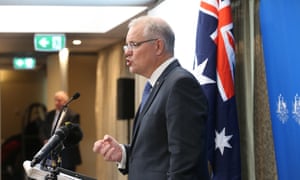Prime minister also signals the government will support the Snowy 2.0 expansion
Scott Morrison
has promised to help accelerate the construction of a new
interconnector between Tasmania and the mainland, and has signalled the
government will back the Snowy 2.0 expansion as part of the Coalition’s
climate policy reboot.
The prime minister confirmed on Monday the government would spend $56m in an effort to progress a new 1,200MW interconnector as part of Tasmania’s “battery of the nation” project and he also sent a strong hint he will back Malcolm Turnbull’s pet project, adding 2,000MW of new generation capacity at Snowy Hydro.
The Tasmanian project is a plan to double the state’s renewable energy capacity by developing pumped hydro energy storage, building windfarms and upgrading existing generation assets. Fourteen pumped hydro sites have been earmarked across the state with a combined potential generation capacity of up to 4,800 megawatts.
Under the plan, renewable energy would be exported to the mainland if a planned second interconnector goes ahead.The prime minister confirmed on Monday the government would spend $56m in an effort to progress a new 1,200MW interconnector as part of Tasmania’s “battery of the nation” project and he also sent a strong hint he will back Malcolm Turnbull’s pet project, adding 2,000MW of new generation capacity at Snowy Hydro.
The Tasmanian project is a plan to double the state’s renewable energy capacity by developing pumped hydro energy storage, building windfarms and upgrading existing generation assets. Fourteen pumped hydro sites have been earmarked across the state with a combined potential generation capacity of up to 4,800 megawatts.
The additional generation projects and transmission infrastructure, as well as potential action to assist the rollout of electric vehicles, were flagged during a speech in Melbourne in which Morrison promised to rebadge and top up funding for the existing emissions reduction fund to the tune of $2bn over 10 years as part of a climate policy pivot.
One of the measures the government has factored in to help meet the 2030 target is a 367 megatonne abatement from carry-over credits (an accounting system that allows countries to count carbon credits from exceeding their targets under the soon-to-be-obsolete Kyoto protocol periods against their Paris commitment for 2030).
The government’s policy shift was panned by Labor, the Greens, a range of climate experts and environmental groups. The shadow climate change minister, Mark Butler, said Labor would scrap the fund if it won the next federal election.
“This has been their policy for the last five years, with exactly the same annual amount put into it as Scott Morrison has promised for the future, and yet we’ve seen carbon pollution go up year upon year, projected to continue to go up all the way to 2030,” Butler said on Monday. “This is a failed policy”.
Bill Hare, a climate scientist and the director of Climate Analytics, said the emissions reduction fund was “a failed policy”, with all independent analysis showing it had not reduced emissions to the extent the government claimed.
“They certainly have not shown up in the national emissions, which continue to increase,” he said.
“The bigger issue is there’s no way the Australian taxpayer can pay for the emissions reductions needed, and nor should they,” Hare said.
“The polluter-pays principle needs to be applied and that means a carbon pricing system would enable companies to make an investment in their production that would benefit taxpayers and the bottom line.”
The Australian Conservation Foundation said the emissions reduction fund had done nothing to cut carbon pollution since its introduction and it was difficult to see how continuing with the same policy would lead to a different result.
“There are serious questions about the governance, effectiveness and value for money of the emissions reduction fund that a new name won’t fix,” Gavan McFadzean, the ACF’s climate change and clean energy program director, said.
“A responsible climate policy must include a whole-of-government and whole-economy approach to reducing pollution, but today’s announcement contains nothing about the energy sector or transport or agriculture or major industry – nothing about cutting pollution from the most polluting parts of our economy.”
Neneh Darwin, a campaigner at Greenpeace Australia Pacific, said topping up the fund was a choice by the government to do “as close to nothing” on climate policy as possible.
“First step in fixing the climate crisis is powering past coal – but the government is doing every single thing it can think of to delay that, including trying to actively prop up the industry by throwing as much taxpayer money at it as they can”, Darwin said.
The Investor Group on Climate Change, which has been focused on the financial risks associated with climate change, said by continuing with the same policy the government was not addressing the serious economic risks climate change exposed Australia to.
“There is a significant gap between the government’s current target and the objectives of the Paris agreement. This is of great concern for investors, as global warming above 1.5-2C would have large and detrimental impacts on global economies, society and investment portfolios,” the group’s chief executive Emma Herd said.
Herd said the government needed to close the gap between its long-term Paris commitments and the current policies urgently. She said investors were increasingly worried about climate change and would keep pushing governments to adopt policies that enabled a smooth transition to a net zero emissions economy.
“The government’s support for investigation into stronger network connection with Tasmania and large scale energy storage is important,” she said.
“This work should be undertaken in the context of the energy market operator’s Integrated System Plan and embedded within a strategy to achieve net zero emissions in the electricity sector.”

No comments:
Post a Comment